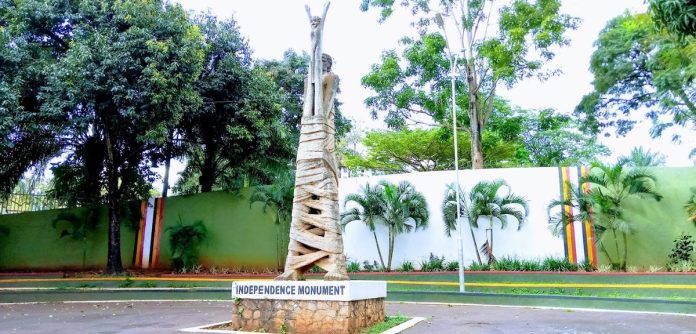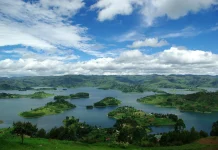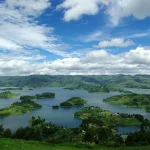The Kampala monument walk offers an opportunity to explore monuments among other sites that highlight Uganda’s rich history and cultural heritage. Other places you might visit on this tour historical buildings, Nakasero and Owino markets, Kabaka’s Palace, and lake at Mengo hill. Those intending to walk can expect to cover a distance of over 5 km across three hills of Kampala which include Nakasero, Mengo and Rubaga hills. The monument walk might last for half day depending on the choice of sites and the time spent at each site. Those not ready to walk can use the preferred means of transport such as a boda–boda tour to get around.
The Uganda independence monument
The Kampala monument walk usually starts from the independence sculpture with an introduction on how Uganda obtained independence from the British Empire on 9th October 1962. The monument is situated along Nile Avenue below Sheraton Kampala hotel gardens in the city center. Standing at 6 meters tall, the concrete and metal sculpture was made in a shape of a mother lifting up a baby raising hands looking towards the sky which symbolizes freedom from colonialism. The British declared Buganda kingdom as their protectorate in 1894 and the name was later shortened to Uganda when all other traditional kingdoms including Ankole and Bunyoro-Kitara Empire were brought under one political unit. Among those that influenced the independence included Sir Edward Mutesa II, the 35th Kabaka of Buganda kingdom who also became the first president of Uganda by the Act of the National Assembly. His statue stands just opposite the independence monument and should be visited as well.
The Statue of leadership
Moving down to Kampala road in front of Amber House is the sculpture of Sir Apollo Kaggwa, the former Prime Minister (Katikiro) of Buganda kingdom between 1890s – 1920s. Kaggwa belonged to the Grasshopper clan, one of the 42 clans of Buganda. He worked to maintain and strengthen traditional institutions within Buganda including Buganda parliament known as Lukiiko that sits at Bulange building on Mengo hill. For instance, he encouraged the documentation of oral traditions, history, and literature in Luganda language. Some of his books include the customs of Baganda and the Kings of Buganda which continue to benefit the generations to learn about the cultural heritage of Buganda kingdom. Kagwa also promoted education within Buganda, encouraging the establishment of schools from 1996 there are 10 private primary schools that offer education to both Ugandan and non-Ugandan children based on the National Curriculum.
Nakasero market
The walk continues to Nakasero food market, one of the oldest markets in Uganda built during the colonial era in the early 20th century. As such, there several old architectural buildings built by Asians that have survived demolition making for a historical trading street. This reflects the contribution to the Indian community to the economic development of Uganda. Most importantly, Nakasero is place where you will experience the lively Kampala’s fresh food scene firsthand. From fruits and vegetables to spices, meats, and local delicacies including grasshoppers and Rolex, Nakasero market is a hub for local farmers, traders. Given that it is uniquely located in the heart of Kampala capital city it is easier to access for those intending to shop for fresh produce. In addition to food, Nakasero market is also vibrant with Ugandan art and culture and attracts street live performances from guitarists to popular Ugandan genres like Kadongo Kamu. Visitors are allowed to showcase their talent with the proper arrangement through a tour operator.
Shikma Indian Temple
When Leaving Nakasero hill walking to Owino market in the downtown area, you can visit the majestic temple. Built in the 1950s and inaugurated in the 1960s by the Shree Sanatan Dharma Mandal faith organization, the temple was built without iron or steel bars yet it has four floors high.
The Uganda Police Directorate of Fire Brigade
Another site not to miss on Kampala monument walk is the Fire Brigade headquarters which is responsible for firefighting and emergency response services in the Greater Kampala Metropolitan Area. It plays a crucial role in ensuring public safety and responding to fire emergencies among other disasters. Visiting the site offers an opportunity to meet with the fire brigade teams and learn about how they safeguard lives and property of Ugandans.
Owino Market
Established in the early 1970s, Owino Market, also known as St. Balikuddembe market is one of the largest and busiest markets in Kampala capital city downtown area. The market offers an incredible diversity of goods both local Ugandan made and imported including fresh produce, clothing, electronics, household goods, and fabrics. At Owino you can witness the entrepreneurial spirit among the youth under the age of 30 who constitute almost 78% of Uganda’s population. In addition to shopping, you can pay homage to the legacy of Ssekabaka Balikuddembe, whom the market was named after. He was among the first people in Buganda kingdom to be baptized as a catholic martyr on 30th April, 1882 by Fr. Lourdel Simeon, the leader of the White Fathers Mission to Uganda. As such, Owino market is a highlight of the Uganda martyrs trail which commemorates the 25 both Anglican and Catholic martyrs that were killed for failure to denounce their religious faith on orders of Kabaka Mwanga. Balikuddembe was beheaded on 15th November, 1885 at Nakivubo when he was 26 years old.
Kabaka’s Palace
From Owino market, you will make your way to Mengo hill, home to the former palace of the king of Buganda. The modern Kabaka’s palace was built in 1922 that replaced the old grass thatched house that was built back in 1885 during the reign of Kabaka Mwanga (II). It was the official residence of the king however. Due to the complex interplay between traditional authority and colonial governance in Uganda’s political history, the former president Milton Obote attacked the palace in an attempt to abolish traditional kingdoms. The attack resulted into a civil war known as the Kabaka crisis of 1966 through which the army created torture chambers within the palace compound where many people who opposed his regime were tortured and murdered.

As such, the palace became an abomination to the kingdom and was abandoned for good that no king shall ever live there again. Mengo Palace stands as a symbol of Buganda’s rich cultural heritage and political history as shown by other monuments and sites that surround it including the Nantawetwa drum, totems, Bulange building and Kabaka’s lake.
Nantawetwa drum
Opposite the palace is the Bulange parliamentary building of Buganda kingdom. The two buildings are connected by a mile long road known as the Royal Mile Walk. In between the path, a big male drum monument called Nantawetwa was built along the roundabout with a gate that’s used only by the Kabaka. According to an oral legend, the Kabaka of in Buganda must follow a straight path when moving to and from the palace to Bulange. So, the monument was created with a gate only for Kabaka to move through and avoid going around the roundabout.
The sculptures of 42 clans of Buganda kingdom
Side by side of the Royal Mile Walk, there are several sculptures representing the totems of some of the 42 clans of Buganda kingdom. Each clan within the kingdom has a specific totem, usually an animal, plant, or object, which represents their ancestry and heritage. Exploring these totems provides insights into the intricate social structure and lineage systems of Buganda society.
Bulange building
Bulange building is the administrative center of Buganda where the parliament (Lukiiko) convenes and is presided over by the prime minister and the clan leaders to discuss important matters concerning the governance of the kingdom.
Kabaka’s lake
Kabaka’s Lake, one of the largest man-made lakes in Uganda, is steeped in history having been commissioned by Kabaka Mwanga II in 1880s. According to historical archives, the king wanted to create a man made water channel connecting to Lake Victoria. The construction of the lake is associated with both practical and symbolic meanings in Buganda culture. For instance, the legend states that the king wanted to create an escape route, which wasn’t fulfilled. Today, the lake acts as a water reservoir and a bird sanctuary and also offers canoeing and boat ride activities.
After exploring Mengo hill and its attractions, the Kampala monument walk comes to an end with lunch at preferred restaurant. Visiting these Kampala monuments among other landmarks offers a holistic view of Buganda’s cultural heritage and history of Uganda at large. Visitors can gain insights from the past to the present generations how traditions, governance structures, and spiritual beliefs have shaped Uganda society over the time.












